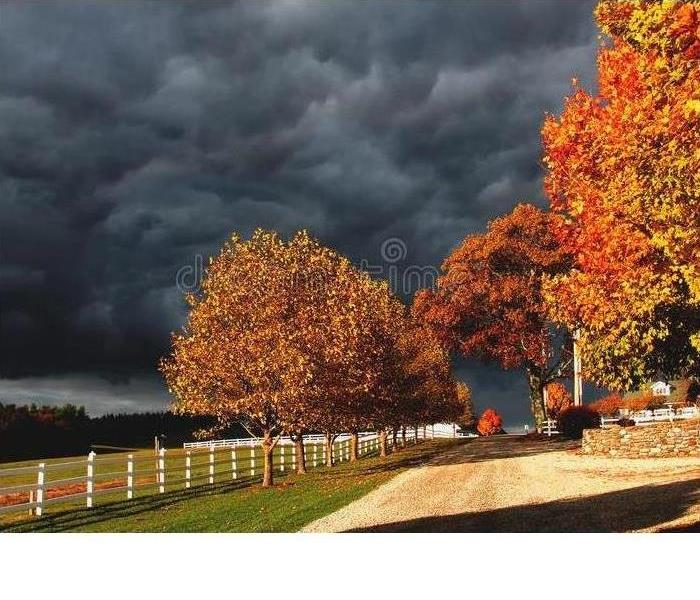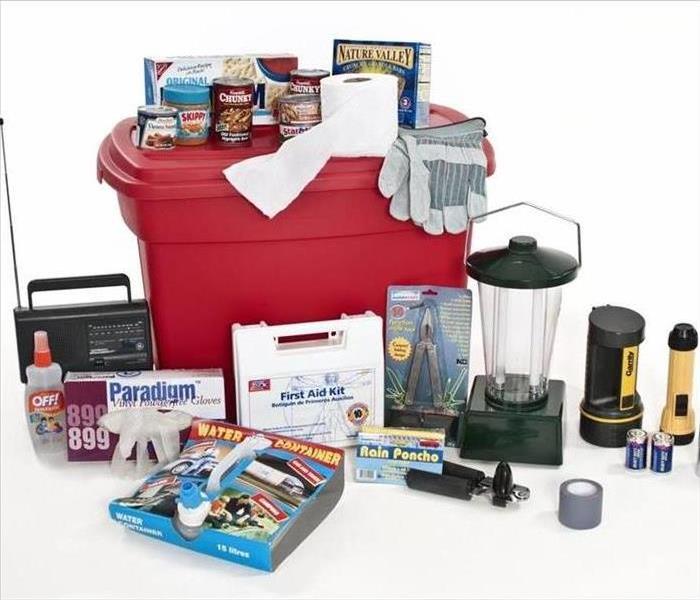Recent Storm Damage Posts
Restoring Hope: Professional Storm Clean-Up Services in North Platte, NE
4/1/2024 (Permalink)
Commercial or residential storm damage may seem daunting, but at SERVPRO of Kearney and North Platte, we're here to help you rebuild and restore after disaster strikes.
Our dedicated Disaster Response Team is trained and equipped to respond swiftly to storm damage emergencies, providing immediate assistance and support. From debris removal to structural repairs, we offer comprehensive storm clean-up services tailored to the unique needs and challenges of each client. We're deeply committed to serving our community and helping residents restore their properties and their lives after a storm, providing compassionate support every step of the way.
In times of crisis, trust SERVPRO of Kearney and North Platte to be your partner in recovery. Contact us today for reliable and compassionate storm clean-up services in North Platte, NE.
Water Damage Cleanup Mistakes
8/3/2022 (Permalink)
Water damage cleanup mistakes can lead to a lot of headaches and stress. If your property needs water damage restoration, here are a few of the mistakes you’ll want to avoid.
Waiting Before Cleanup
Water damage can lead to a lot of problems. The first rule of cleanup is to do it as soon as possible. Every minute that your belongings and property stay submerged lessens the chances of you getting that item or property back to its pre-damaged state. If you wait until it’s convenient to perform the cleanup, you’ll only end up with bigger problems.
Wrong Equipment
Using the wrong equipment will only aggravate the problem. Plus, the kind of equipment or tools you have might not be suitable for handling the water in your home. That means you won’t succeed at drying your home completely, which will leave your home at the mercy of mold and mildew growth. Don’t let that happen. Hire pros to handle this for you. They have specialized equipment to ensure the fast and efficient drying of your belongings and property.
Neglecting Important Details
Most of the time, people forget about the items they slog through when they wade through water damage. But there could be an electrical problem, broken glass, and other items that could injure you. It’s best that you hire pros instead of tackling this on your own. Restoration experts know what to look out for and how to do this in the safest way possible. They’re much better equipped to handle this than you with your makeshift tools.
Not Doing Your Homework
When you look for a restoration service, don’t hire the first company that you find. Look at the company’s history and background. SERVPRO of Kearney and North Platte is your trusted resource for cleaning and restoring water-damaged property. Our teams are IICRC certified. We have the latest advanced equipment and training to make sure your water damage problems are solved completely.
If you have water damage to your home or business property, call us anytime 24/7 at 308-535-1115. We'll be there to help!
Spring Storms Affect the Kearney and North Platte Area
3/9/2022 (Permalink)
Whether it's your home or your business, strong storms can wreak havoc on your property.
Living in the Kearney and North Platte area we have grown accustom to living with the lively weather patterns that the spring season brings.
Sometimes, there's not much you can do to protect your property when 100+ MPH winds hit. Generally, we focus on what's most important... our loved ones. After the storm clouds clear a small percentage of our population will find damage to their homes and businesses.
SERVPRO is prepared to assist after spring storms.
So whether it's a flooded basement in your home, or the entire roof ripped from your building, there's only one call to make. The cleanup professionals at SERVPRO of Kearney and North Platte quietly taking to the streets 24 hours a day, 7 days a week with the best training and equipment. Call us at 308.535.1115
We are prepared to do the hard work necessary to make it "Like it never even happened."
Is Your Carpet Ruined After a Flood?
11/8/2021 (Permalink)
Floods can bring contaminants, dirt, and soil into your home. Even after removing the standing water and drying a property, these stains can remain on surfaces, particularly those porous materials like carpets.
Performing flood damage restoration in Nebraska area home relies on expertise and effort. SERVPRO technicians are trained to recognize different carpet damage types from absorption to agglomeration and water exposure. Using tried and tested methods, we can often return carpets and textiles to an original condition. At the end of service, one of our crew chiefs can guide you through the property to explain the outcomes of restoration and effective restoration of materials.
- Burn tests and chemical tests are performed as standard to avoid further damage.
- Our hot water extraction techniques are effective at removing soils from carpets, textiles, and other porous materials.
- Roto machine buffering can restore the luster of wet carpets in the property.
Restoring rather than replacing materials is more cost-effective. Contact SERVPRO of Kearney and North Platte for flood damage restoration at (308) 535-1115
How Landscaping Can Help Slow Flood Damage
11/8/2021 (Permalink)
Have you ever seen a school science demonstration of water being poured into two equal containers of soil, but one has plants growing and one does not? In the box void of vegetation, the water runs out the bottom nearly as quickly as it flowed in. In the box containing rooted plants, only a minimal amount of water trickles out. This experiment shows the importance of proper water management around your property. Learn how you can become one with the flow, using easy landscaping projects to prevent storm run-off from causing outside flooding around your home in the Kearney and North Platte area.
- Slow the flow. Apply a deep layer of heavy mulch to slow rain drainage, giving it time to filter through the soil instead of pooling or running off to problem areas.
- Cultivate plants. Installing plants and shrubs at the base of your home can help slow the flow of water and prevent outside flooding. If you have a particular area where water tends to pool during storms, consider making a rain garden. This shallow basin is not a bog or a pond, but it uses plants to filter the rain water and facilitate its travels to the water table.
- Be a water mover. During the next rain storm, check the flow of water from your roof. Look for areas that need rerouted and consider adding rain chains, moving gutters, or adding flexible extensions to downspouts to direct water away from your foundation.
- Keep water captive. Add a rain barrel to the end of a downspout and feel good about your impact on the environment when using that recovered water to help take care of your plants.
Outside flooding can cause damage to structures on your property.
When water damage happens, it can quickly lead to mold trouble since mold spores are abundant in the environment and reproduce quickly. Professional water mitigation specialists can help clean up flood water and ensure materials are dried thoroughly to prevent your minor problem from becoming a major one.
When to Replace your Roof
10/12/2021 (Permalink)
When it comes to knowing how often you should replace your roof, there really isn’t any hard and fast rule. You have to keep an eye on its condition to be able to tell if you need to start thinking about it. If your roof is showing signs of damage, that could lead to major water or storm damage to the rest of your home. Our team wanted to share a few potential issues your roof may develop; any one of these may mean it’s time to replace your roof.
Age
An asphalt shingle roof should last between 20 and 30 years, so if you have a 40-year-old roof, just keep in mind that you will probably need to replace it entirely in the next 1-5 years.
Shingles
Shingles can curl in two ways: by “cupping,” which happens when the edges of the shingles turn upward; and “clawing,” which is when the edges stay flat and the middle starts to come up. Both are signs of weathering and indicate that potential leaks may possibly be developing, depending on the extent. Every homeowner finds themselves replacing a missing shingle, but it can be just about impossible to get a new shingle to match the color of an old one. Granule colors have changed pretty significantly over the years, and shingle colors often change with years of weathering. If your roof is starting to look like a patchwork quilt, you may want to consider replacing it soon.
Damage
Cracked shingles are typically caused by wind damage, and if the damage is extensive and not isolated to just one area, you should start thinking about replacing your roof within the next few years.
Algae Or Moss
This is not a big deal when it shows up on your roof, but it doesn’t give your home or business a great look. You don’t want to take matters into your own hands by power washing or scraping it away since that will often chip off all the protective granules and essentially render your shingles useless. You can use a wash that's one part bleach and one part water to remove algae or moss, and if you do decide to replace your roof, consider tiles that are algae-resistant.
Light
This issue is pretty obvious: if light can get in through your roof, so can rain. If you see any water stains during the next rainfalls, and if they spread or expand, you have an active leak, and it is time to contact SERVPRO of Kearney and North Platte immediately to help remediate the water damage and potential mold growth.
Sagging
A sagging roof is typically an indication of a structural issue and demands immediate attention. There could be a problem with the decking in the attic or with the supports in the foundation, which is even worse. You're not necessarily in imminent danger, but this is the kind of thing that's a lot easier to take care of when it's small and localized, so call your roofing professionals right away for this roofing issue.
When it comes to replacing your roof, there is no hard and fast rule. If you are experiencing water damage, it is probably time. Remember that SERVPRO of Kearney and North Platte is here to help if you are dealing with water damage, fire damage, or a mold infestation.
Preparing Our Youth For Disasters and Emergencies
10/1/2021 (Permalink)
When the unexpected happens, will your child know what to do? Disaster can strike anywhere, usually with little to no warning. If your child is put in an emergency situation and doesn't know how to react, they could be severely hurt and may even feel significant anxiety that can follow them for years. With the proper education, though, your child can feel more secure, confident and helpful in the event of a disaster.
Preparing Our Youth
Ultimately, it takes the whole community to educate our youth through preparedness tips and advice. With everyone doing their part, children will understand the seriousness of an emergency situation and strive to become leaders in their classrooms and neighborhoods, ensuring that everybody is prepared for the next disaster. The Federal Emergency Management Agency (FEMA), the American Red Cross and the Department of Education have worked together to create the National Strategy for Youth Preparedness Education, a document that outlines a vision for prepared youth in the United States, and how communities can turn that vision into a reality. This document seeks to educate youth and their parents so that communities are better able to prepare for, respond to and recover from future disasters.
How to Prepare Youth for Emergencies and Disasters with Nine Steps
The National Strategy document indicates nine crucial steps that people and organizations at the local, state and federal levels should take to create a strong and prepared youth community. Here's how you can help prepare young people for several types of emergencies and disasters:
- Make it important. Elevating the importance of youth preparedness learning programs in schools and civic organizations allows children to recognize that being prepared is crucial throughout every area of the community.
- Evaluate. If existing youth preparedness programs aren't up to par, develop guidance, tools and up-to-date protective actions in order to ensure that the children in your community are given proper direction.
- Support. Communities, organizations and schools should be able to prepare children without facing unnecessary resistance or interference.
- Create. Establish a relationship between local youth and the first responder community, so that your kids can understand how first responders react in emergency situations. Your kids can also learn from their own heroes what they can do to help in a disaster.
- Link. Connect youth preparedness to family and community participation, so that your child can become an advocate in your area.
- Make school preparedness key. Schools, by their nature, promote broad community participation already, so adding preparedness programs that include curricula, drills and exercises for all local disasters can help children understand what to do when faced with a crisis.
- Build and strengthen. Creating and maintaining partnerships among stakeholder agencies and organizations allows your community to receive up-to-date information about youth preparedness best practices. Local leaders can also be advocates to discuss your community's needs, especially if your area is prone to certain natural disasters.
- Identify. Find opportunities to insert youth preparedness education into youth culture, such as using social media or local ads to initiate a conversation about the importance and effectiveness of preparedness programs.
- Design. Create a sustaining model that designs, develops and delivers valuable programs to train youth in your community. Since certain areas are known to have specific recurring natural disasters, it's important to create a plan that's unique to your community's needs.
By implementing these nine priority steps in your community, your children can receive training to help them feel confident when faced with a disaster. Giving them the tools they need to understand how to prepare for, respond to and recover from several types of emergencies – from fires to floods and more – can make all the difference when disaster actually strikes.
Flooding and Your Basement
10/1/2021 (Permalink)
A flooded basement hits like an oncoming train. Whether the problem stems from a broken pipe, failed sump pump or the result of a heavy downpour that found its way inside, a flooded basement needs to be dealt with immediately to prevent long-term damage.
When dealing with basement floods, there are some things you can and should do immediately, some things you might want to consider doing in the future and times when you should really call in the professionals.
Flooded Basement: Safety First
Safety should always be a priority. Entering a wet basement can be dangerous and even deadly. Before stepping into a flooded basement consider the following:
- Is there a risk of electrical shock? If it's safe to access the main breaker box, turn off the power before you enter the basement. If the breaker box is located in the flooded basement, contact your local power company or a trusted electrician to help first.
- Do you smell gas? Gas leaks are deadly and dangerous. If you smell gas, get out of the house and alert your utility company.
- Is the flood water contaminated? Sewage, chemicals and other pollutants in flood waters pose a health risk to humans and animals. Avoid contact with contaminated flood water and any items that may have been in contact with contaminated flood water.
- Is the flooded basement still structurally safe? If there is any question regarding the structural integrity of the flooded basement or the house above it, do not enter. Call for professional help.
How to Clean Up a Flooded Basement
If it's safe to enter, there are several things you can do to begin cleaning up your flooded basement. Before you dive in, remember the first rule is always safety. Wear protective clothing, safety glasses and gloves as you clean and inspect the basement. Make sure the space is well-ventilated, which also speeds the drying process.
Retrieve and remove: The quicker your personal items can be removed from water, the better the chances for repair and restoration. You need to get items out of the basement and dry off any remaining dampness to reduce the likelihood of mold growth.
Extract water: If the water is just a couple inches deep, you may be able to remove it using a wet/dry vacuum or portable sump pump. Both of these items can be rented rather than purchased. If you're wading through several inches of water or more, though, you'll likely need to call in professionals like those at SERVPRO of Grand Island and Hastings.
Remove rugs: Any area rugs need to be removed and dried out immediately. If possible, hang area rugs outdoors to dry or opt for a professional cleaning. If the basement was carpeted, you may have to remove the carpet. Water can damage not only the carpet fibers but also the glue, backing, padding and underlayment, leaving the carpet at higher risk for mold. However, do not attempt to remove tacked-down carpeting yourself, leave it to the professionals.
Run a dehumidifier and fans: To prevent the development of mold after a basement flood, it's essential to keep the level of humidity as low as possible. If the weather is favorable, open any and all windows you can, then run a dehumidifier and fans to increase ventilation and lower the humidity levels.
Clean and disinfect: After the water is extracted and the basement thoroughly dried, the whole space needs to be cleaned and disinfected. Carefully wash and sterilize anything the flood waters touched that you were able to salvage.
Keep an inventory list: As each item is removed from your flooded basement and treated for water damage, add it to an inventory list. Keep a record of all the details regarding what was damaged in the flood, and hold onto estimates and receipts from any restoration or repair procedures. These documents will support any insurance claim you plan to make.
SERVPRO has been helping homes and businesses cope with water damage for more than 54 years. When your basement floods, call SERVPRO of Grand Island and Hastings to handle the water extraction, drying and any necessary mold remediation
Best Helpful Hints to Get You Through the Winter and Storms
3/8/2021 (Permalink)
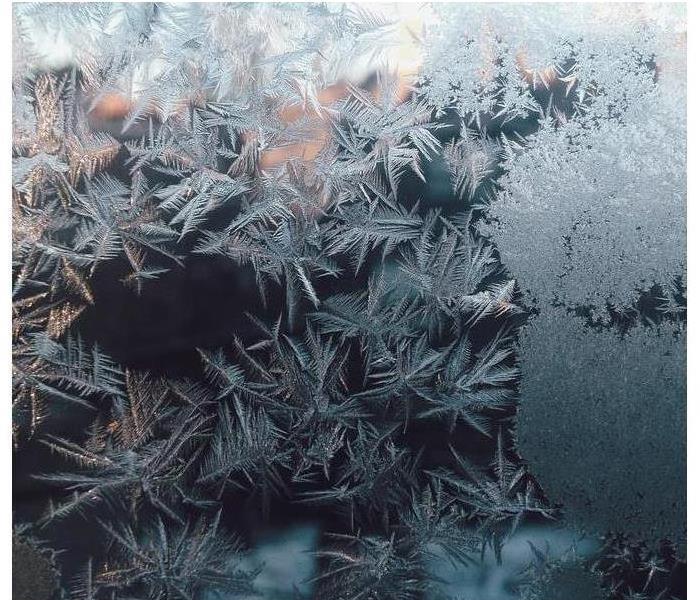 We know winter storms on on their way, so you can call on us when things get out of hand and the cold affects your home or business.
We know winter storms on on their way, so you can call on us when things get out of hand and the cold affects your home or business.
- Ceiling fans are not just for summer: flip the switch to reverse the spin of the fan and turn on the lowest speed to blow warm air down from ceiling.
- Use energy from the Sun: During the day, open drapes and blinds to allow sunlight to help warm the house, land then close at night to hold in heat.
- Dress in Layers: Pack an extra pair of warm socks, blankets, wool sweaters and long-johns or coveralls in your car to keep warm.
- Keep a bag of clay kitty litter in car: If your car gets stuck in deep snow or slick ice, sprinkle kitty litter (non-clumping) at the base of your tires to add some traction to get moving again. Extra weigh in trunk will create added pressure on your tires, ensuring greater contact between your tread and the ground.
- Don’t smoke or drink coffee before shoveling: Caffeine and nicotine are stimulants and can add extra stress to the heart.
- Learn to walk like a penguin: To walk safely on ice, walk like a penguin. Point your feet out, land hold your arms out slightly to your side. Shuffle, land take short steps.
- Easy deicer: The night before freezing temperatures, rub half a potato over your car’s windshield. The sugar from the potato creates a barrier over the window and prevents ice from forming, when you come out in the morning you will not have to scrape! Simply rinse and wipe with your wipers when you get on the road.
- Gas Up: During cold weather months, it is good practice to keep at least a half tank of gas in your vehicle at all times. Not only does it prevent you from being stranded, but it prevents any water in the tank from freezing, which can damage the fuel pump.
- Frozen locks: Squirt a little hand sanitizer on them. The isopropyl alcohol that kills germs also lowers the freezing point of water, and can melt the ice inside the lock within seconds.
- Grab a roll of duct tape and keep it in car: Not only does it fix everything, but you can use it as a fire starter – duct tape is very flammable and is a great tool to get a fire going in an emergency. Don’t forget to have a lighter or matches in your emergency kit.
- Candles: will keep you warm in your car if you are stranded in car. Also, don’t forget to have a lighter or matches.
- No more icy walkways: Sprinkle leftover coffee grounds on your freshly shoveled walk or driveway to help melt the ice – it’s a natural and environmentally friendly way to add more traction underfoot. Remember to wipe feet when going inside.
- Dry wet shoes: by stuffing them with dry newspaper to absorb the moisture quicker.
- Shoveling Snow: Spay shovel with non-cook cooking spray, snow will slide off easier.
- Winter Survival Kit to keep in vehicle: Flashlight, batteries, snacks, water, ice scraper, first aid kit, candle and lighter, phone charger, warm outer clothing and travel shovel.
Frozen Pipes: A Winter Water Damage Emergency
11/6/2020 (Permalink)
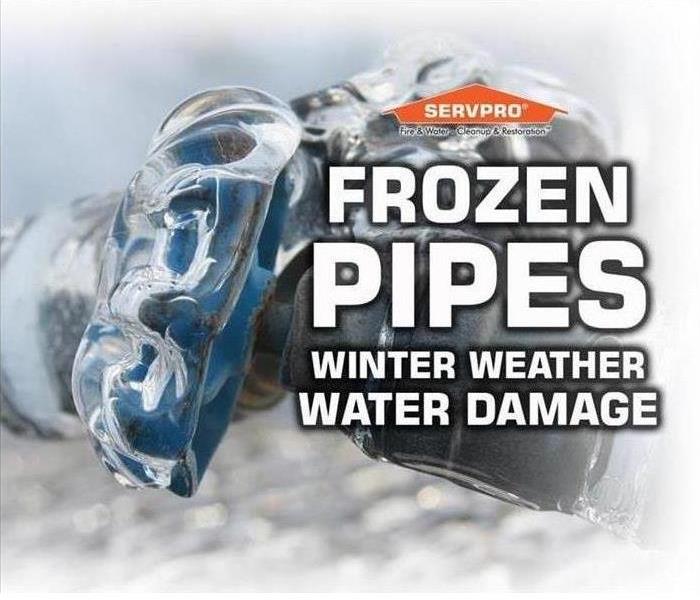 Low Temperatures can freeze pipes, make sure you are keeping an eye on your home during winter.
Low Temperatures can freeze pipes, make sure you are keeping an eye on your home during winter.
We can’t control the weather frigid winter temperatures are here in the Midwest, the lower temperatures cause a new set of seasonal Nebraska property disasters including frozen pipes, ice dams and other frozen water damage concerns.
Every winter our SERVPRO of Kearney & North Platte professionals help countless homes with the restoration, cleanup and repair of their property following a frozen water property disaster.
Why is a Frozen Pipe a Concern?
- When water begins to freeze, it expands. This can cause both plastic and metal pipes to burst, possibly leading to significant water damage to your home or business.
- Since water expands when it freezes, it puts unwanted pressure on pipes.
- As water freezes, the force exerted from the expansion can cause a pipe to burst, regardless of the strength of the material.
- You may not know you have a burst pipe as the water has turned to ice. Once the temperature starts to warm and thawing begins, leaking and flooding can occur.
FROZEN PIPE WATER DAMAGE TREATMENT AND RESTORATION
The key to avoiding costly secondary damage is to handle every water problem as a real threat to your property with proper mitigation. Our SERVPRO of Kearney & North Platte team has the equipment, training and experience to find and dry unseen water before secondary damages occur. We begin removing the standing water from your property with extraction methods, and rapidly dry your structure and contents with dehumidifiers that lower the indoor humidity levels, so your building dries out quickly. When time matters, technology and equipment must be counted on to perform. SERVPRO of Kearney & North Platte professionals will answer your call with rapid action and a full arsenal of drying equipment.
FROZEN PIPE PREVENTION
Short- and Long-term solutions for low temperature plumbing problems include:
- Locate and seal cracks and openings in the walls, attic, basement or crawlspace.
- Weather strip and caulk around crawlspace doors and basement windows.
- Make sure your home is properly insulated. Pay special attention to areas where pipes are located.
- Insulate unprotected pipes and don't leave gaps. Pipe sleeves simplify the process. Keep the pieces tight against each other and seal the slits and joints with duct tape.
- Install storm windows over basement windows or replace the old windows with energy-efficient alternatives.
- Find your main water shutoff so you can turn off the water quickly if needed. Locations vary — look in the crawlspace or basement where the water supply enters the house, inside a water meter box directly outside the house or near the water heater.
- Open cabinet doors under sinks to let warm air flow around the supply lines. Move any cleaners or other chemicals out of the reach of children.
- Keep your thermostat at the daytime setting during the night. If you'll be away for several days during subfreezing weather, keep it set above 55° F.
Autumn Storms
11/6/2020 (Permalink)
Autumn storms are right around the corner. The effect of these storms can be good or bad. As much as we love the sound of thunder, the jolt of lightning going through the sky and the smell of rain, there are bad things that can come along with it. Power outages are often a risk associated with storms. It’s good to know what to do in case you lose power, because you never know how long it could be out. It could be out for a matter of seconds, or for several hours. Here are some tips on what how to be prepared, and what to do during a power outage.
- Keep flashlights available around your house. Avoid using candles when possible.
- Keep the opening of freezers and refrigerators to a minimum. When kept closed, refrigerators can stay cool up to 4hours, and freezers can stay frozen up to 48 hours. If need be, you can put ice in a cooler to keep your food cold.
- Watch out for carbon monoxide poisoning. If you are running a generator, it should be used outside and at least 20 feet away from a window or door. Never use a gas stovetop, oven, camp stove, or charcoal grill to heat your home.
- If it’s cold in your home, add more layers of clothes and blankets. Don’t use the oven or a grill as a heating source. If it becomes too cold, try to make arrangements to go to another location where heat is available.
- Turn off and disconnect any appliances and electronics. The power may surge or spike when it is restored, and that may cause damage to the items.
- If you have a sump pump, keep an eye on it so you don’t end up with a flooded basement.
If a storm occurs, the safety of you and your family is of the utmost importance. Be safe out there!
SERVPRO of Kearney & North Platte specializes in the cleanup and restoration of residential and commercial property after a fire, smoke or water damage event. We can handle any size disaster!
Call us at (308)535-1115
Prepare your home or business for winter weather
10/28/2020 (Permalink)
 Prepare your home for winter weather
Prepare your home for winter weather
Winter weather brings freezing temperatures, and the Tigard/Tualatin and surrounding area is anticipating snowy conditions. Ensure your home or business is prepared by reading the tips below.
- Drain water from the swimming pool and water sprinkler supply lines. Do NOT put antifreeze in these lines unless directed; antifreeze is environmentally harmful and is dangerous to humans, pets, wildlife, and landscaping.
- Close inside valves supplying outdoor hose bibs. Open the outside hose bibs to allow water to drain. Keep the outside valve open so that any water remaining in the pipe can expand without causing the pipe to break.
- Add insulation to attics, basements and crawl spaces, if needed. Insulation will maintain higher temperatures in these areas.
- Ensure that areas, where water supply lines are located, are insulated enough. Consider leaving kitchen and bathroom sink cabinet doors open and dripping overnight if you think they risk being frozen.
- Consider installing specific products made to insulate water pipes. Newspapers can provide some degree of insulation and protection to exposed pipes - even ¼” of newspaper can provide significant protection in areas that usually do not have frequent or prolonged temperatures below freezing.
If you will be going away during cold weather, leave the heat on in your home set to a temperature no lower than 55 degrees Fahrenheit. Temporarily suspend the use of lower nighttime thermostat temperatures to lower the risk of frozen pipes.
SERVPRO of Kearney & North Platte specializes in the cleanup and restoration of residential and commercial property after a fire, smoke or water damage event. We can handle any size disaster!
Call SERVPRO of Kearney & North Platte (308) 535-1115.
You Can Weather any Storm
10/19/2020 (Permalink)
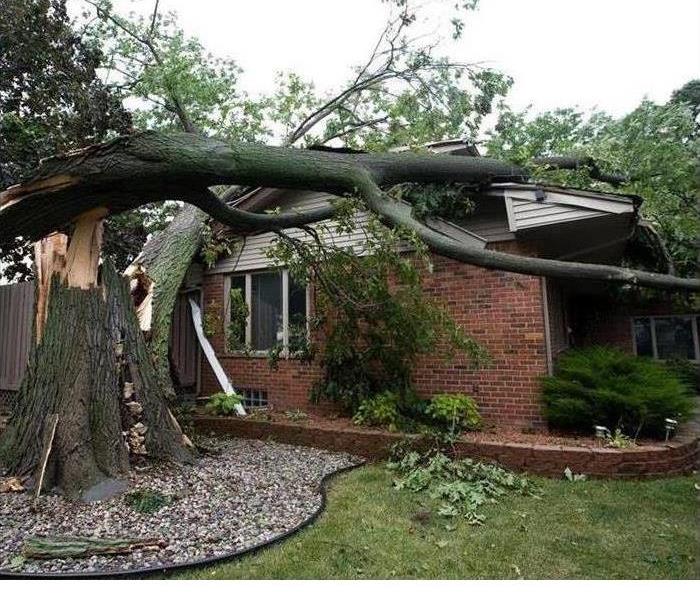 Storm damage
Storm damage
As a business, it is your job to weather any storm that comes your way no matter the type or size. Sometimes physical storms are unexpected and can be quite devastating and detrimental to a business. Here at SERVPRO, our job is to give some peace of mind and help instigate water and fire damage cleanup and restoration. We are capable of traveling anywhere to help get the property back to preloss conditions. Our SERVPRO team of franchise professionals have access to a semi-trailer that is meant to stock up for any disaster that could strike your business. We make our services available 24 hours a day for 365 days a year for whatever could happen. We want to ensure you will be helped during overwhelming and unexpected times. We come ready for whatever disaster occurs. No matter the weather or time of day, we will be there to assist.
SERVPRO of Kearney & North Platte specializes in the cleanup and restoration of residential and commercial property after a fire, smoke or water damage event. We can handle any size disaster!
Call us at 308.535.1115
Getting Prepared for any Disaster
3/10/2020 (Permalink)
The American Red Cross encourages that each household and car have a preparedness kit, but sadly only 51.5% of US homes reportedly have an emergency kit ready. Kits should include things like water, canned food, a can opener, flashlights and batteries, including enough food and water for each person in your household for 5 days. Start with a power outage kit, grab an old backpack or duffel and add in plenty of bottled water, battery-operated radio, and clock, flashlight for each member of your household including extra batteries, non-electric can opener, list of emergency phone numbers including family and friends and a first aid kit.
SERVPRO of Kearney & North Platte specializes in the cleanup and restoration of residential and commercial property after a fire, smoke or water damage event; as well as mold remediation. We can handle any size disaster!
Call us today at 308.535.1115






 24/7 Emergency Service
24/7 Emergency Service

